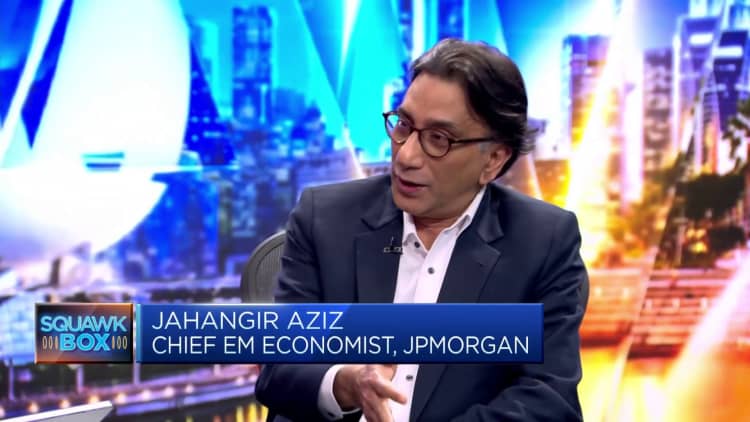Chinese Premier Li Qiang delivers a speech during the opening of the second session of the 14th National People's Congress at the Great Hall of the People on March 5, 2024 in Beijing, China.
Lintao Zhang | Getty Images News | Getty Images
BEIJING – China set a growth target of “about 5%” for 2024 and announced the issuance of special “long-term” bonds for major projects, according to a government work report on Tuesday.
Premier Li Qiang, who presented the report, also pledged that China would remove restrictions on foreign investment in manufacturing.
China set its deficit-to-GDP ratio at 3% for this year, down from a rare upward revision to 3.8% late last year from the original 3%.
The work report also said that Beijing will issue “long-term” special treasury bonds worth 1 trillion yuan ($138.9 billion) this year to finance major projects in line with national strategies, while 3.9 trillion yuan of special purpose bonds will be issued to local governments. This year, 100 billion yuan more than last year.
“We should appropriately enhance the intensity of our proactive fiscal policy and improve its quality and effectiveness,” the work report said.
The budget deficit excludes private bonds, political bank bonds and local government financing vehicle debt, according to Louise Lu, chief economist at Oxford Economics, who last week forecast a deficit of 3% to 3.5%.
An IMF report earlier this year said its conversations with Chinese officials indicated they viewed fiscal policy last year as proactive.
“Ultra-long-term special treasury bonds issued on a trial basis will not be included in the deficit, and may be issued at an appropriate time based on market and economic conditions under the trend of a moderate increase in the central government's leverage to ensure the stability of the economy,” said Bruce Pang, chief economist at real estate consulting firm JLL. , in a translation of his comments on CNBC: “Flexibility.”
“It may gradually replace the issuance of local private bonds to better support the country's large and long-term strategic planning, construction of key regions and implementation of large-scale infrastructure projects,” he added.
Two courses
The GDP targets and other economic indicators were published as part of the opening of the annual meeting of the National People's Congress in Beijing, which was attended by more than 2,800 delegates on Tuesday.
Last year, the Chinese economy grew by 5.2%, which is in line with the official target of about 5%. The overall recovery from the pandemic has been slower than many expected, while growth also faced pressure from falling real estate and exports.
This year, China plans to target an urban unemployment rate of about 5.5%, create 12 million new jobs in urban areas, and increase the consumer price index by about 3%. The goals for 2024 were the same as those set for 2023.


In 2023, the National Bureau of Statistics said the country had an average unemployment rate of 5.2% in cities and created 12.44 million jobs. However, the CPI rose 0.2% amid weak demand.
The work report stressed the need to “ensure high-quality development and greater security,” prevent risks and maintain social stability, among other tasks.
He called for the implementation of the decisions and plans of the Central Committee of the Communist Party of China.
China's economic policies for next year are usually discussed by senior party leaders in December. Local governments hold their own meetings to set regional growth targets, before the National People's Congress announces the target for the entire country.
In recent years, Beijing has reduced this number in favor of what it calls “high-quality” growth.
Chongqing Mayor Huang Henghua told reporters on Tuesday that the municipality aims to increase its gross domestic product from 3 trillion yuan last year to 4 trillion yuan by 2027.
Although it is “very difficult,” the municipality also has the “foundation and conditions” to achieve this growth “with a little bit of a leap,” Huang said, according to a CNBC translation.
Chongqing is one of the largest cities in China and reports directly to the central government, as do Beijing and Shanghai.
Defuse risks
“Internal engines of development are being built,” the work report said, but added that the country must be “well prepared for all risks and challenges.”
China pledged to improve long-term risk prevention and control mechanisms.
“We will implement a package of measures to defuse risks arising from existing debt and protect against risks arising from new debt,” Beijing said in the work report. He added, “We will take prudent steps to defuse risks in small and medium-sized financial institutions in some localities and will take strict measures against illegal financial activities.”


China also pledged to “meet justified financing requests for real estate enterprises under different forms of ownership on an equal basis” and “make concerted efforts to defuse local government debt risks while ensuring stable development.”
China's real estate problems are closely intertwined with the finances of local governments, as they have historically relied on land sales to developers for a significant portion of revenue.
The property market slumped after Beijing cracked down on developers' heavy reliance on debt for growth in 2020 – bankrupting some of its biggest property developers and impacting consumer growth and broader growth in the world's second-largest economy.
“Preventing and defusing risks in certain areas remains a difficult task,” the National Development and Reform Commission, China's top economic planning agency, said in its annual work report.
“Hidden risks, such as debt-related risks and financial risks, are still prominent in some regions, and it takes time to foster a new development model in the real estate sector.”
